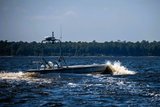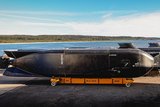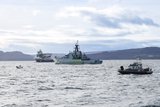US Coast Guard pursues solutions to increase maritime domain dominance
Cutter Campbell conducts small boat operations in the Windward Passage. (Photo: US Coast Guard)
The US Coast Guard (USCG) is conducting market research to identify real-time, networked, unified technologies, services and applications capable of increasing naval predictive awareness while accelerating the decision-making process.
The capabilities should support the construction of a “detect-to-act” pipeline connecting the branch’s aerial and naval fleet, its inventory of uncrewed systems and its space, air, surface and shore-based sensors.
“The Coast Guard is not looking for a singular solution to provide the MDD [maritime domain dominance] capability, but rather a holistic and/or collection of capabilities to achieve this desired outcome,” the service stated in a request for information (RfI) published
Already have an account? Log in
Want to keep reading this article?
More from Naval Warfare
-
![How the Anduril-HHI autonomous ship plan fits in with the US Navy’s MASC programme]()
How the Anduril-HHI autonomous ship plan fits in with the US Navy’s MASC programme
The new modular vessel is expected to be developed for both commercial and defence use, with a heavy focus on production speed and mission flexibility.
-
![Indo Pacific 2025: Autonomous systems reigned but can the Australian Defence Force afford it?]()
Indo Pacific 2025: Autonomous systems reigned but can the Australian Defence Force afford it?
Multiple autonomous systems and technologies were on display at this year’s Indo Pacific, but questions remain over how the Australian Department of Defence will balance the books.
-
![How the UK Royal Navy is powering up its hybrid fleet to combat new threats]()
How the UK Royal Navy is powering up its hybrid fleet to combat new threats
Since it announced its move towards a new “hybrid navy” earlier this year, the force has announced a number of new uncrewed technologies in the works.
-
![US and UK to begin Trident II D5 Increment 8 in October 2026]()
US and UK to begin Trident II D5 Increment 8 in October 2026
Trident II D5 Increment 8 will involve improvements to the shipboard navigation subsystem for the US Ohio and Columbia and the UK Dreadnought and Vanguard submarine classes.






















